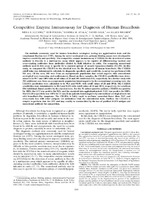Por favor, use este identificador para citar o enlazar este ítem:
http://sgc.anlis.gob.ar/handle/123456789/268| Título : | Competitive enzyme immunoassay for diagnosis of human brucellosis | Autor : | Lucero, Nidia E. Foglia, Luis Ayala, Sandra M. Gall, David Nielsen, Klaus |
Palabras clave : | Brucelosis;Brucella;Anticuerpos Antibacterianos;Técnicas para Inmunoenzimas;Humanos | Fecha de publicación : | 1999 | Descripción : | The methods commonly used for human brucellosis serological testing are agglutination tests and the complement fixation test (CFT). Among the newer serological tests, primary binding assays were developed to improve sensitivity and specificity. The competitive enzyme immunoassay (CELISA) for the detection of serum antibody to Brucella is a multispecies assay which appears to be capable of differentiating vaccinal and cross-reacting antibodies from antibodies elicited by field infection in cattle. The competing monoclonal antibody used in this assay is specific for a common epitope of smooth lipopolysaccharide (S-LPS). In this study, we compared the CELISA to the classical tests for the diagnosis of human brucellosis. The CELISA cutoff value was determined to calculate its diagnostic specificity and sensitivity. A survey was performed with 911 sera. Of the sera, 341 were from an asymptomatic population that tested negative with conventional serological tests (screening and confirmatory). Based on these samples, the CELISA specificities were determined to be 99.7 and 100% with cutoff values of 28 and 30% inhibition (%I), respectively. In a further study with 393 additional sera from an asymptomatic population found negative by the conventional screening tests, the CELISA specificities were calculated to be 96.5 and 98.8% with cutoff values of 28 and 30%I. The CELISA sensitivities were determined to be 98.3 and 94.8% with cutoff values of 28 and 30%I, respectively, for sera from 116 individuals found positive by the classical tests. For the 51 culture-positive patients, CELISA was positive for 100%, the CFT was positive for 92%, and the standard tube agglutination test (TAT) was positive for 100%. The CELISA specificity was 100% for 31 sera from patients found negative by conventional serological tests but with brucellosis-like symptoms. The CELISA is fairly rapid to perform, somewhat faster than TAT, and cross-reacts less with other antigens (or antibodies) than the conventional tests. Further, the CELISA is simpler to perform that the CFT and may readily be standardized by the use of purified S-LPS antigen and monoclonal antibody for competition. Fil: Lucero, Nidia E. ANLIS Dr.C.G.Malbrán; Argentina. Fil: Foglia, Luis. Academia Nacional de Medicina de Buenos Aires. Centro de Investigaciones Epidemiológicas; Argentina. Fil: Ayala, Sandra M. ANLIS Dr.C.G.Malbrán; Argentina. Fil: Gall, David. Canadian Food Inspection Agency. Animal Diseases Research Institute; Canadá. Fil: Nielsen, Klaus. Canadian Food Inspection Agency. Animal Diseases Research Institute; Canadá. |
URI : | http://sgc.anlis.gob.ar/handle/123456789/268 http://jcm.asm.org/content/37/10/3245.full.pdf+html |
ISSN : | 1098-660X | Derechos: | info:eu-repo/semantics/openAccess |
| Aparece en las colecciones: | snrd Publicaciones INEI |
Ficheros en este ítem:
| Fichero | Descripción | Tamaño | Formato | |
|---|---|---|---|---|
| JournalofClinicalMicrobiology,1999,37(10),3245–3248..pdf | 65.14 kB | Adobe PDF |  Visualizar/Abrir |
Visualizaciones de página(s)
202
comprobado en 23-dic-2025
Descarga(s)
85
comprobado en 23-dic-2025
Google ScholarTM
Consultar
Los ítems de DSpace están protegidos por copyright, con todos los derechos reservados, a menos que se indique lo contrario.

